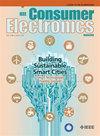物联网机器学习和设备邻域融合算法
IF 4.3
2区 计算机科学
Q1 ENGINEERING, ELECTRICAL & ELECTRONIC
引用次数: 0
摘要
在物联网中,信息融合是关键问题之一,并且可能由于消费电子设备的密集部署而发生。在文献中,已经开发了各种方法来微调原始数据;然而,消费类电子产品的邻域信息却一直被完全忽视。在本文中,为消费电子设备开发了一种机器学习和邻域辅助融合方法,以确保捕获的数据值在各自边缘进行进一步处理之前得到适当的改进。在这种方法中,每个服务器接受来自部署在其覆盖区域内的电子设备的成员请求邀请。它应用著名的k -均值和支持向量机(SVM)算法来细化消费电子设备捕获的数据值。除此之外,服务器模块还具有内置的智能来比较这些电子设备的捕获数据值,这些电子设备位于附近并且可能具有更高的冗余比率。仿真结果表明,所提出的机器学习辅助融合方法是物联网的理想解决方案,特别是人工智能支持的物联网。此外,所提出的算法通过各种性能评估指标(如寿命、能效和精细化比)进行了彻底的检验,结果令人信服,如融合比提高了30%。本文章由计算机程序翻译,如有差异,请以英文原文为准。
Machine Learning and Device’s Neighborhood-Enabled Fusion Algorithm for the Internet of Things
In the Internet of Things, information fusion is among the crucial problems and probably occurs due to the dense deployment of consumer electronic devices. In the literature, various methodologies have been developed to fine-tune raw data; however, consumer electronic devices’ neighborhood information has been completely ignored. In this manuscript, a machine learning and neighborhood-assisted fusion approach has been developed for consumer electronic devices to ensure that captured data values have been properly refined before onward processing at the respective edge. In this approach, every server accepts member request invitations from electronic devices deployed in its coverage area. It applies the well-known K-mean and supports vector machine (SVM) algorithms to refine captured data values by consumer electronic devices. Apart from that, the server module has the built-in intelligence to compare the captured data values of those electronic devices, which reside nearby and probably have a higher redundancy ratio. Simulation results have concluded that the proposed machine learning-assisted fusion approach is an ideal solution for the IoT in general and the Artificial Intelligent-enabled IoT in particular. Additionally, the proposed algorithm was thoroughly examined via various performance evaluation metrics such as lifetime, energy efficiency, and refinement ratio, where it has shown convincing results such as 30% improvement in the fusion ratio.
求助全文
通过发布文献求助,成功后即可免费获取论文全文。
去求助
来源期刊
CiteScore
7.70
自引率
9.30%
发文量
59
审稿时长
3.3 months
期刊介绍:
The main focus for the IEEE Transactions on Consumer Electronics is the engineering and research aspects of the theory, design, construction, manufacture or end use of mass market electronics, systems, software and services for consumers.

 求助内容:
求助内容: 应助结果提醒方式:
应助结果提醒方式:


